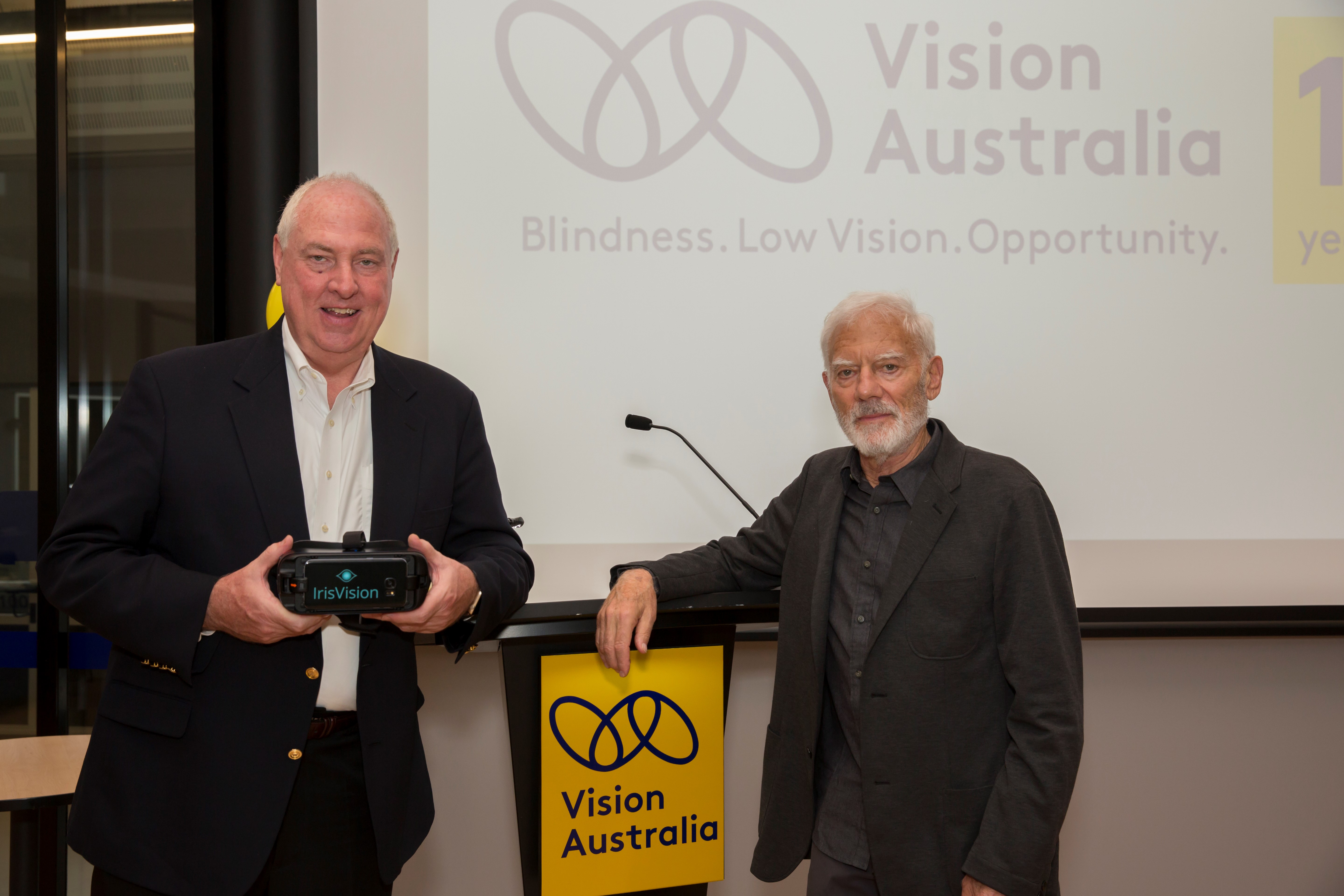Renowned international vision scientist Professor Frank Werblin and low vision pioneer Tom Perski recently visited Australia to highlight new technology that’s not only bringing back sight to people with low vision, but ‘bringing back life’.
In Australia to host two exclusive events at Vision Australia, Professor Werblin and Mr Perski explained and demonstrated how IrisVision is allowing people with eye conditions such as age-related macular degeneration to see loved-ones’ faces, watch TV, read books and see pieces of art that they haven’t been able to in years.
At the age of 19, Mr Perski was diagnosed with a rare case of Stargardt macular dystrophy, a genetic eye disorder which causes progressive vision loss.
“At the time, my favourite things were sports and art. Very quickly after my diagnosis I wasn’t able to do either of my favourite things anymore,” Mr Perski said.
“With the help of aids such as CCTVs, I was able to study and work and there has been some incredible advancement in technology in the past 40 years but when I first heard about IrisVision, one of the first places I went to visit was the Chicago Art Institute to see all the paintings that I used to study when I was a young man," he said.
“It was just incredible. I’ve never had an experience like the one I had that day. I stood there, one metre away, with all the other people observing the painting and I saw the whole painting.
“There was this moment when my brain clicked, and all of a sudden, I had tears streaming down my face. I think my brain thought I could see again, that’s how good this device is.
“Throughout my career, I’ve seen and been part of other technologies that were fair, but weren’t life-changing – this device is life-changing.

And it’s all thanks to vision scientist Professor Frank Werblin, who after studying vision and trying to restore vision at the University of California Berkeley for the past 40 years decided he would develop a device that could help people with low vision.
“I thought with a background in physiology and engineering, I could design something to help people with low vision. At first, I had devices that were the size of a refrigerator before I realised a few years ago that everything I needed was beautifully integrated in a smart phone, so why not use that?” Professor Werblin said.
“The camera, the display and the processor were all there, so we repurposed the Samsung phone and the virtual reality headset that had been originally designed for gaming.”
It was when Professor Werblin started fitting the device to people with low vision that he realised the possibilities it could create.
“It was remarkable, people with low vision were blown away. I never expected it to be so successful and so powerful, so quickly.
“Over time, I began to understand why it was so effective. It’s because it has a very broad field and you really feel immersed in the visual world.”
The IrisVision enhances contrast, clarity and sharpness while doing all the focussing.
“Some of the people I’ve fitted IrisVision to include a high school student who is now planning on going to college and an 87 year-old woman who loved to sing in a choir but wasn’t able to read the music or see the conductor. She can now see both using the IrisVision.
“This is really life-changing for people and one of the reasons for that is because it restores the ability to see people, to see expressions and faces, to be able to go to a football game, or a theatre, or find things of the supermarket shelf. You lose all of this with low vision and it makes you socially isolated and I think this brings back vision but it also brings back life to people with low vision.”
Mr Perski added, “A lot of the devices for low vision have had an emphasis on reading and don’t allow you to see any further than the length of your arm and that limits you, because life becomes encapsulated in this sphere that’s about as big as your arm. That can become very socially isolating.
“We’ve never really had anything that’s worked for music or playing cards – things that are further away from you. Now, finally you can look across the room or across the street.”
About IrisVision
IrisVision is a wearable device built on the most advanced mobile virtual reality (VR) platform. It allows people with low vision conditions such as macular degeneration to see clearly in all aspects of daily life, with an industry-leading 70° field of view and adjustable IrisBubble view.
The IrisVision is particularly suitable for eye conditions that cause a central vision loss such as Aged Related Macular Degeneration, Stargardt’s Disease and Diabetic Retinopathy. Other eye conditions that IrisVision will benefit are Ocular Albinism, Cone Rod Dystrophy, Retinopathy of Prematurity and stroke resulting in low vision.
IrisVision is available in Australia exclusively through Vision Australia. Note this device is currently on back-order. Check with your local Vision Store for up-to-date information on availability.










